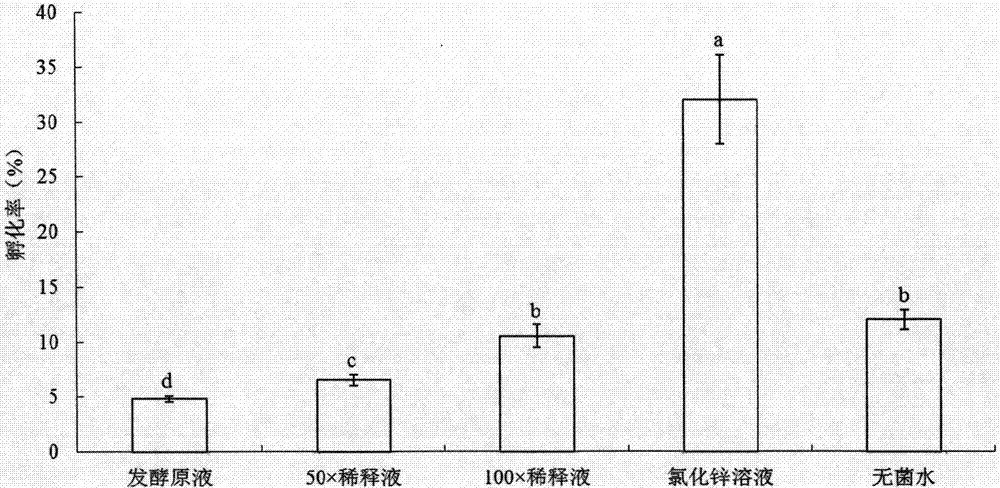Lecanicillium attenuatum and application of lecanicillium attenuatum to control of crop nematodes and bemisia tabaci
A technology of leucococcus attenuatorium and Bemisia tabaci, which is applied in the field of leucococcus attenuatorium, can solve the problems of excessive pesticide residues in agricultural products, high toxicity, ecological environment pollution, etc., achieves great application potential, inhibits hatching, and has good parasitic effects. Effect
- Summary
- Abstract
- Description
- Claims
- Application Information
AI Technical Summary
Problems solved by technology
Method used
Image
Examples
Embodiment 1
[0019] Embodiment 1: Isolation of Lecanococcus attenuata bacterial strain of the present invention
[0020] With the aphids infected with Lecanococcus spp. collected from Cuba, after 3% NaClO surface disinfection, the dead worms are placed on the prepared medium, and the medium formula is PDA medium, that is, 200g of potatoes (peeled, cut into pieces and boiled 30min, gauze filter), glucose 20g, agar 20g, add distilled water to 1000mL, high temperature sterilization at 121°C for 30min. Place 3 dead worms in each petri dish, then place the petri dish in a constant temperature incubator at 27°C for cultivation, observe regularly, pick the growing hyphae onto PDA medium, and store them at 4°C after the mycelium is full. To be identified.
Embodiment 2
[0021] Embodiment 2: Colony character culture and morphological identification of the Lecanococcus attenuata bacterial strain of the present invention
[0022] The strain was inoculated on a PDA medium plate, cultured at 27°C, and the colony shape, color and colony growth of the strain were continuously observed until the colony covered 2 / 3 of the plate. After 10 days on the PDA medium, the colony of the strain is white, thin flocculent, and the back is colorless. Using the glass slide culture method, the PDA medium was made into small slices of 2cm×2cm, the activated mycelium of the fungus was picked on the medium, and placed in a 27°C constant temperature incubator for moisture cultivation, and continuously in the Olympus CX21BIM-SET6 microscope system Observe the formation of conidia and bottle stems of the fungus, measure and take pictures. The conidiophores of this strain are undeveloped and resemble vegetative hyphae, on which there are solitary, opposite or 3-4 whorls ...
Embodiment 3
[0023]Example 3: Molecular biology identification, ITS sequence alignment and phylogenetic analysis of the present invention's Lecanococcus attenuata strains. The CTAB method was used to extract the total DNA of the strains (Kim D H, Martyn RD, Magill C W. Restriction fragment length polymorphism groups and physical map of mitochondrial DNA from Fusarium oxysporum f. sp. niveum. Molecular Plant Pathology, 1992, 82: 346-353.). Use general primers ITS1-F and ITS4-R (White T J, Bruns T, Lee S. Taylor JW. Amplification and direct sequencing of fungal ribosomal RNA genes for physilogenetics. In: Innis M.eds. A PCR protocols: a guide to methods and applications. New York, USA: Academic Press, 1990, 315-322.), PCR amplification and sequencing of ITS sequences. PCR reaction system (20 μL): 1 μL of template DNA, 1 μL of PCR Master Mix (Thermo Fisher Scientific), and 1 μL of primers, supplemented with deionized water to 20 μL. Reaction conditions: 94°C for 4min; 94°C for 1min, 55°C for...
PUM
 Login to View More
Login to View More Abstract
Description
Claims
Application Information
 Login to View More
Login to View More - R&D
- Intellectual Property
- Life Sciences
- Materials
- Tech Scout
- Unparalleled Data Quality
- Higher Quality Content
- 60% Fewer Hallucinations
Browse by: Latest US Patents, China's latest patents, Technical Efficacy Thesaurus, Application Domain, Technology Topic, Popular Technical Reports.
© 2025 PatSnap. All rights reserved.Legal|Privacy policy|Modern Slavery Act Transparency Statement|Sitemap|About US| Contact US: help@patsnap.com



